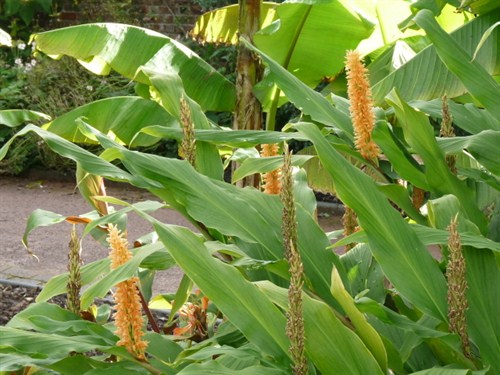Autumn rages against the dying of the light
Sunday, October 28, 2012
A vibrant and enjoyable month full of colour from a wide range
of plants. Leaf colour on trees and shrubs came almost overnight
from the end of September onwards but it seemed that almost as soon
as they coloured the leaves dropped - no long lingering autumn
there!! Unlike the border plants with dahlias, salvias, later
flowering knipfofias especially k. rooperi and a range of annuals
still belting it out in an impessive show of defiance to the
approaching winter.
Evening sunlight on larch trees - our view to the north
from Cilgwyn Lodge
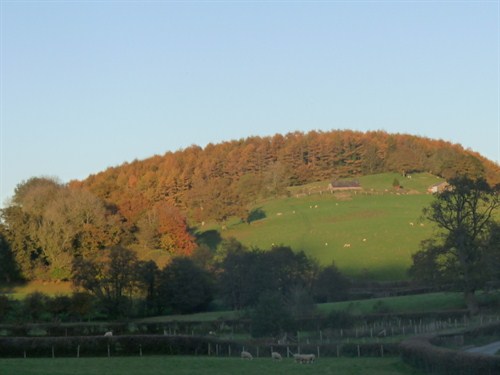
There were a few nervous moments when the thermometer plunged to
around freezing on several nights mid month but with some emergency
covering of more tender plants with horticultural fleece, no damage
was done. Just as I was thinking that we would get through October
without a real frost Last Friday night put paid to that and by
Saturday morning the colour show was brought to an abrubt end. In
such an abysmal summer it was even sadder to see it go than usual -
you always want it to go on for ever - just like life itself! Dylan
Thomas got it right .. "rage, rage, rage against the dying of the
light"
Red hot pokers living up to their name. Kniphofia
rooperi the latest form we grow which does take a degree or so of
frost
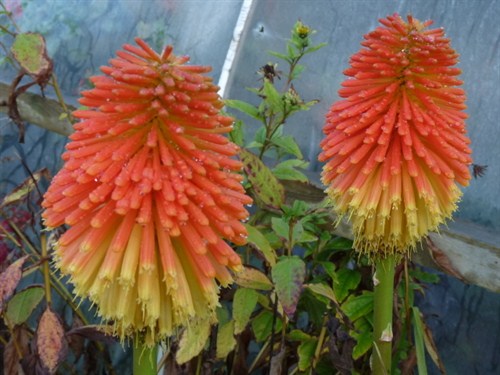
Weather
A mixed month with some strong winds, heavy rain (nothing new
there!) sunshine and some surprisingly warm days and nights.
Good weather for growth. Max 17C min -2C
Garden update
It's the time of the year with less to do that you can enjoy the
garden more. There is no doubt that planting with autumn in mind
pays dividends; dahlias, asters, crocosmias and sedums to name just
a few are border stalwarts for this time of year but tender salvias
are something relatively new and a range of annuals
especially cosmos, late sown nicotianas and rudbeckias really raise
the colour threshold. I wish I could grow nerines well because
their sugary pink confection in mass is a sight to behold.
Just a few miles away from us is a cottage garden
which year after year has a fantastic show of nerine bowdenii - the
owner told me they thrive on neglect. Obvioulsy I must be trying
too hard!
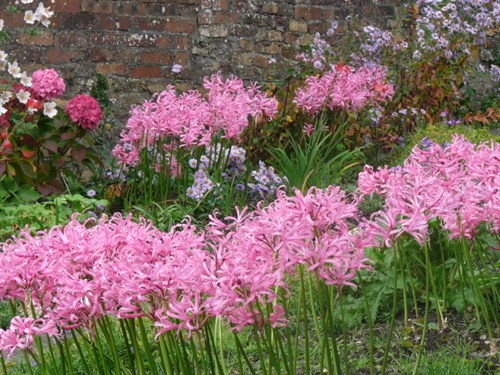
Back at Cilgwyn a good stand of late flowering nicotiana
silvestris from seed sown in early April. Still a good scent on
warmer days and proving reasonably frost resistant

It's also time to consider the composition of flower borders and
to remove clumps that have become too large or are starting to go
back. Autumn is a good time to split herbaceous plants. There is no
doubt that at Cilgwyn if we don't address planting in the borders,
they start to look stale. Removing and splitting herbaceous plants
at this time of year gives them a chance to establish themselves in
pots for sale next year or in new locations elsewhere in the
gardens.
In the last few days days I have been giving the lawns a major
scarifying to clear the masses of thatch that has built up during
the summer. They look a bit sorry for themselves at present but
with a good feeding with autumn lawn fertiliser they should look
fine by next spring.
The Padddock Garden lawn the day after the
scarifying

As far as vegetables are concerned this year, the only hope we
have is to look forward! Our own veggies won't get us through the
winter as they did last year. It has continued to be the most
difficult year with poor growth, weeds, slugs, rabbits and cabbage
white caterpillars causing havoc. If it wasn't for the brassicas I
would be desperate. There were some other positives too: celeriac
is the biggest I have ever had and celery has enjoyed all the rain
and is tender and virtually stringless - that is quite and
achievement for me as I believe that good celery is the hardest
vegetable to grow well. We harvested our last runner beans "Stenner
strain" on 19 October and are still cropping a few courgettes from
heavily protected outdoor plants.
What's looking good?
Raspberries have flourished in the wet cool weather which has
produced a good crop over a long period. "Autumn Bliss", a good old
fashioned late season cultivar with a strong flavour has provided
berries almost continuously from late June to date. It achieves
this by flowering firstly on last years wood during summer, then on
this years wood into the autumn. Very good value if you only have a
small space. Only the varieties classed as primo canes can do this,
but I have to say that the flavour in my opinion is not as sublime
as the summer flowering forms.
There are some good late clematis still in flower, the star of
the show being clematis viticella "Blue Belle" a vigorous and very
reliable form with a 2 - 3 month flowering period. We also have the
last flowers on c. rehderiana, and flowering for the first time
with small greenish yellow flowers, c. tibetana ssp vernayii, a
member of the tangutica group, the so called "orange peel"
clematis.
Clematis viticella "Blue Belle" on 23
October
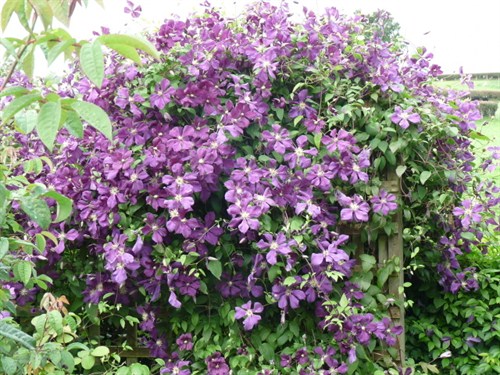
Clematis rehdereana seed heads and the last few flowers.
A big plant that will easily spread to 15 feet in a few
years
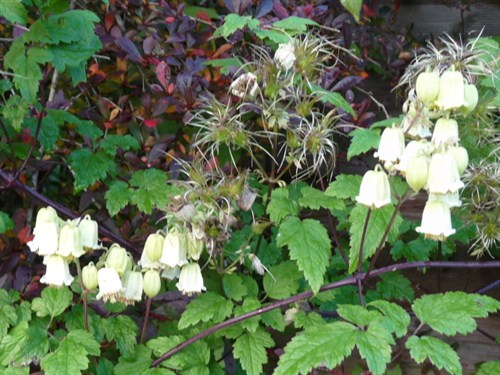
The rudbeckia show continues untroubled by all the weather,
fantastic value for a few packets of seed; they are anuuals but
have all the ruggedness and sense of permanence of a perennial. The
latest to flower has been a vibrant orange/yellow with a deep
magenta centre the name of which has escaped me!!
The mystery rudbeckia
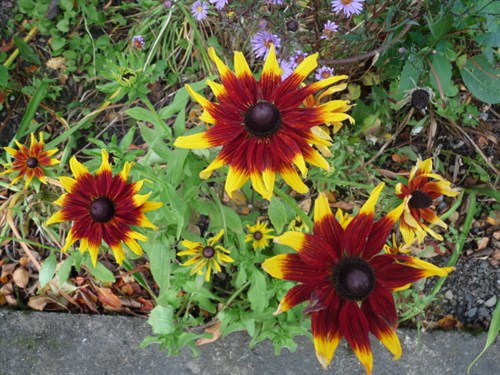
The Red Border in the lower light of a sun filled afternoon
looks more ethereal than in high summer, with dahlia "Wittemans
Best" a wonderful semi cactus bright red showing up well in the
front of the border, a planting decision I made in the spring to
bring the colour up closer. Ocasionally it pays to move away from
the conventional border design of short plants at the front and
tall plants at the backand a few taller ones brought forward can
make a big impact but I am not thinking any time soon of putting
short ones at the back!
The Red Border showing dahila "Wittemans Best" at the
front of the border and the mellow late sunshine

Aconitums are familiar plants for autumn colour usually in good
shades of deep blue. A more muted alternative but a very
interesting and attractive colour break in light lavender can found
in aconitum carmichaellii Wilsonii group to around 4 feet tall. It
is usually about 50% true from seed.
Wildlife and countryside
A few fieldfares spotted in last week or so but not the mass
arrivals with their cousins the redwings we often get at this time
of year. I was saddened to read recently that because of high winds
and fog many may have perished at sea on their journeys to the UK
from Scandinavia and Russia where they spend the summer.
There are a lot more jays around this year, colourful birds with
a raucous call. The corvids (crow family") are much in evidence
with crows, magpies, jackdaws, and ravens a common sight.
A couple of months ago I wrote about the sun bathing blackbird
on the Paddock Lawn. I should have known better to put a human
interpretation on animal behaviour. Earlier this month all was
revealed: the blackbirds had mites or fleas and their plumage was
in poor condition and by spreading themselves on the grass they
were giving ants the chance to devour the pests.
The rams have been busy this last couple of weeks and one of my
favourite breeds the texels are doing their stuff in the Park which
adjoins Cilgwyn Lodge.
Meet one of our neighbours - the 2 legged kind are much
better looking!
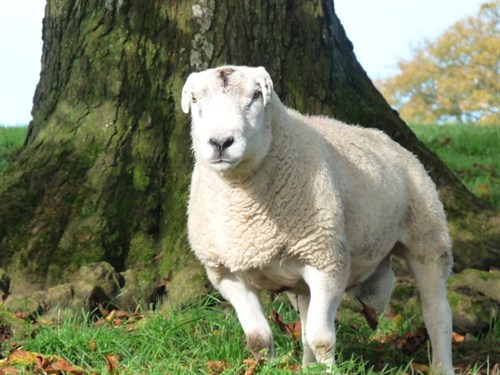
Visits
Talks at 5 clubs this month with some very lively and well
attended meetings. I appreciate all the feedback I have received
from club members. "Growing Vegetables" and "Autumn Colour" are
currently the most requested topics.
Excitement is mounting as we are getting closer to our trip to
North Wales for Medwyn Williams "Vegetable Masterclass Weekend" at
Llanberis between 9 and 11 November. I never thought I would be
asked to speak at such a presitigous event and although somewhat
apprehensive I am looking forward to it immensely and to listening
to the fantastic range of other speakers who will be appearing.
Hopefully some pics. next month and a full report.
It wouldn't be October without a visit to Hergest Croft Gardens,
Kington, Herefordshire for the annual Plant Fair. A good range of
stalls but a lower attendance than usual even though the weather
was superb. Nevertheless a lot of plant buying was in evidence and
the event was lifted by the presence of Roy Lancaster and other
luminaries from the RHS including the current President whose
family own the Gardens. A must see garden, it is open from Easter
to the end of October. Make a note in your new diaries to visit
next year. You won't be disappointed.
Hergest Croft sits comfortably in its 40 acres of
gardens and arboretum
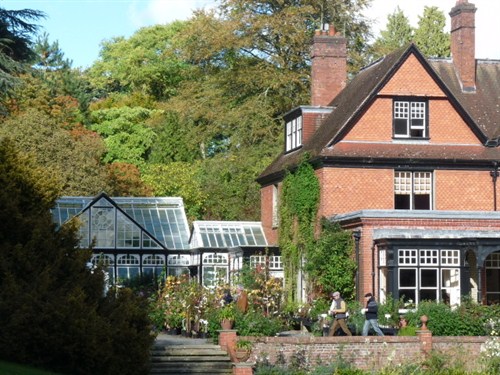
The Plant Fair at Hergest in full swing
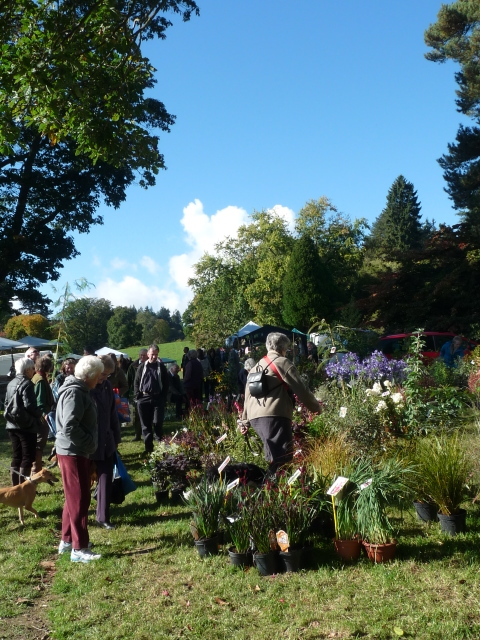
One last garden outing closer to home to The National Botanic
Garden of Wales with so much to see in the shorter opening hours
for winter - The Double Walled Garden looking superb with fine
stands of hedychiums (gingers) in several forms. The Tropical House
has matured very well in the last few years. This, with the iconic
Great Glasshouse housing collections from Mediterranean climates
around the world, make it worth a visit at any time of the year
(and it is only closed on Christmas Day!!)
The Great Glasshouse and surrounding
parkland
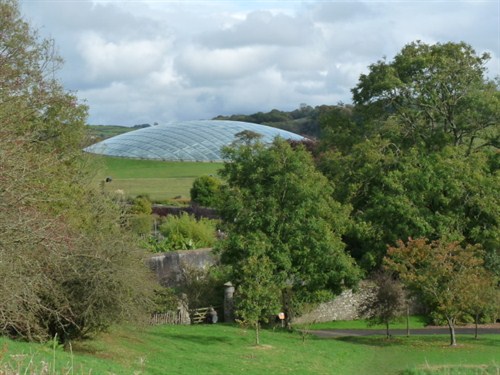
A fine stand of hedychium densiflorum a reliably hardy
ginger in the Double Walled Garden
